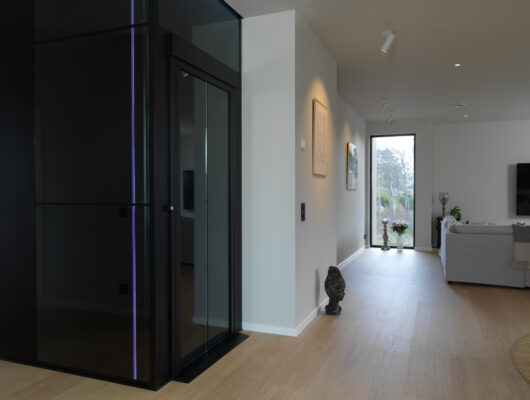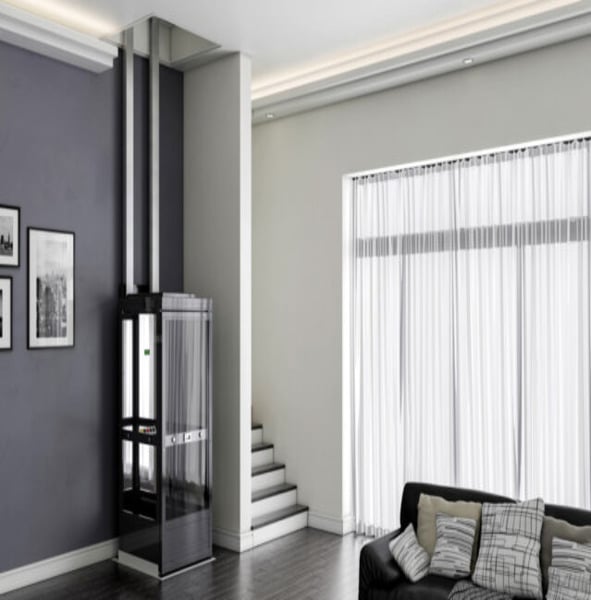Traction Elevator – How Does it Work?
A Traction elevator is one of the most common types of lift systems used in tall commercial and residential buildings. It is powered by a motor and relies on ropes or cables wound around a drive sheave to move the elevator car. While the traction elevator mechanism is ideal for high-rise applications, its suitability for homes is more limited. Let’s explore how it works, the components of a traction elevator, and whether a traction home elevator is the right choice.
How Does a Traction Elevator Mechanism Work?
- A motor winds ropes or cables connected to the top of the elevator car.
- These ropes pass over a drive sheave that rotates as the motor runs.
- The car is counterbalanced by a weight that moves in the opposite direction, reducing strain on the motor.
- This counterweight system ensures stability, efficiency, and smoother vertical travel.
This design allows traction elevators to handle heavy loads and travel at high speeds, making them ideal for tall buildings with frequent usage.

Components of a Traction Elevator
Key parts that make up a traction system include:
- Drive Motor – Powers the system and rotates the sheave.
- Drive Sheave – A grooved wheel that guides the ropes.
- Hoist Ropes or Cables – Connect the elevator car and counterweight.
- Counterweight – Balances the weight of the car and reduces motor effort.
- Controller System – Manages speed, acceleration, and braking.
- Brake System – Ensures passenger safety during stops.
Each of these components of a traction elevator plays a vital role in achieving efficiency, safety, and smooth operation.
Benefits of Traction Elevators
Although not typically recommended for homes, traction elevators excel in tall buildings and commercial spaces. Key benefits include:
- Ability to Handle Heavy Loads
- With a counterbalanced system, traction elevators can move heavy goods and passengers with ease.
- This makes them popular in shopping complexes, hospitals, and office towers.
- Flexible Design Options
- Traction elevators offer customization in car interiors, lighting, and control systems.
- This flexibility allows architects to integrate them seamlessly into modern building designs.
- Smooth and Comfortable Ride
- The cable-driven system provides a stable, refined experience.
- Quiet operation enhances building ambiance, making rides more pleasant for occupants.

Disadvantages of Traction Home Elevators
While they have clear advantages for large buildings, a traction home elevator comes with notable drawbacks:
- Higher Cost
- More expensive to install and maintain compared to screw-and-nut or hydraulic lifts.
- Complexity and Maintenance
- Requires specialized installation and repair expertise.
- Finding technicians for home service can be difficult and costly.
- Power Consumption
- Uses more electricity than some alternatives, leading to higher energy bills.
- Space Requirements
- Needs more room for cables, sheaves, and a machine area.
- Not suitable for smaller residential layouts.
- Noise Levels
- Tend to be noisier than platform lifts or screw-driven systems, which may disrupt the quiet of a home environment.
Should You Choose a Traction Elevator for Your Home?
- If you live in a tall commercial or residential building, a traction system is often the best option.
- For private homes with 2–6 floors, the drawbacks usually outweigh the benefits.
- Homeowners often prefer modern alternatives like SWIFT Pro and SWIFT Lite, which provide compact installation, smooth operation, and lower maintenance without the complexity of traction systems.
Final Takeaway
The traction elevator mechanism is proven, reliable, and highly effective for high-rise and commercial buildings. However, for homeowners, factors such as cost, complexity, noise, and space requirements make it less practical. Instead, solutions like SWIFT Pro are specifically engineered for modern houses, offering a safer and more efficient alternative to a traction home elevator.
For elevators designed for residential comfort and style, explore the unique features of SWIFT Pro today.










